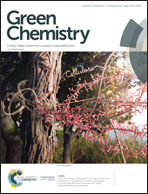Homogeneous versus heterogeneous catalysis in Cu2O-nanoparticle-catalyzed C–C coupling reactions†
Abstract
Copper based nanocatalysts have recently emerged as attractive catalysts for a diversity of bond formations, such as C–C, C–N, C–O, C–S, and C–Se. However, the identification of truly heterogeneous versus homogeneous catalytic conditions remains an ongoing challenge within the field. Herein, we report that in cuprous oxide (Cu2O) nanoparticle-mediated C–C homo-coupling and cross-coupling reactions, the presence of a base facilitates the copper complex mediated homogeneous catalytic pathway. Whereas in the absence of a base, the reaction can proceed heterogeneously on the surface of Cu2O nanoparticles. We distinguished the homogenous versus heterogeneous pathways using a combination of reactor study, ultraviolet-visible extinction spectroscopy, electrospray ionization mass spectrometry, flame atomic absorption spectroscopy, transmission electron microscopy, and density-functional theory calculations. Our findings indicate that Cu2O nanoparticles can catalyze C–C coupling reactions under lingandless and base-free conditions via a truly heterogeneous pathway paving the way for the development of highly efficient, robust and sustainable processes.



 Please wait while we load your content...
Please wait while we load your content...